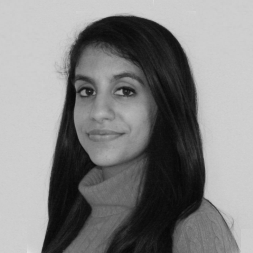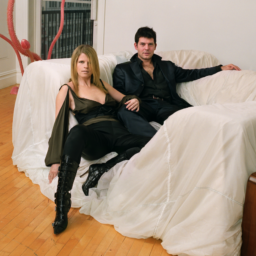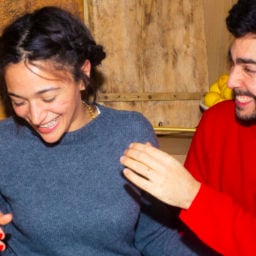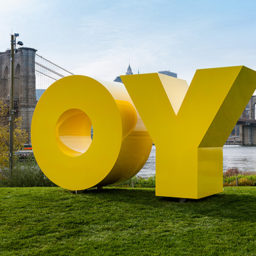New York artists Deborah Kass and Patricia Cronin are easily one of the city’s most politically engaged art-world power couples—and their mutual love of politics is, in fact, how their romance began.
Both artists have long been passionate about advocating for the rights and representation of women in creative circles and beyond, exploring feminist themes in their respective work, from public sculptures like Cronin’s Memorial to a Marriage—a bronze mortuary sculpture conceived before gay marriage was made legal in the United States—to Kass’s subversive Pop paintings, like her famous self-portrait in the manner of Warhol’s Liz.
In their adjoining studios in Gowanus, Brooklyn, the couple sat down with Artnet News to discuss how they met, why they continued to inspire one another, and how they’d like to see the art world change in the years to come.
How did you first become acquainted?
Deborah Kass: Go ahead, Patti.
Patricia Cronin: We met when I was co-curating an exhibition called “Coming to Power: 25 Years of Sexually X-plicit Art by Women” with the artist Ellen Canter in 1993. This was before the internet—if you were trying to organize a group show, you found out which artists’ studios you should go visit through word of mouth and from other artists. I had known Deb’s work from when she was showing on 57th Street with Baskerville + Watson gallery, and also knew about the work she did with José Freire at Fiction/Nonfiction. So, I went to her studio, and that’s how we met.
What were your initial impressions of each other?
Kass: Well, I didn’t think I was right for the show. So I told Patti and Ellen that.
Cronin: She did tell us—and she was probably right—but while we were there, she also told us about this political-action group that she was co-founding with Mary Dorman and Annie Philbin, who’s the longtime director of the Hammer Museum. The three of them cofounded WAC, the Women’s Action Coalition. And she said, “You should really start coming to these meetings. They just started, they’re really exciting.” So we started meeting at the meetings. I’d show up and she’d be leading the meetings. It was great—we discussed and organized different political actions all over the city.
So, then did you go on a date?
Kass: No, I was with someone else. I didn’t pay much attention. Patti, we should probably talk about the interview.
Cronin: Oh, right. I had started visiting New York in 1981, and then I moved to the city in ‘86—and when you first move to New York from out of town, you go to see all the shows. Mira Schor and Susan Bee were just starting this journal called Meaning with artists’ writings, so I proposed that I interview Deb for that. We did what I felt was a really great interview in 1993, and we talked about lots of issues around sexuality, gender, and representation. It was really fun.
Kass: And then I broke up with my other girlfriend and the rest is history.
Wow. What’s something you liked about each other right away?
Kass: Well, I’ll tell you what I told my first love about Patti. I called him to tell him I was breaking up with my then-12-year relationship. He said, “Well, what’s she like?” And I said, “She’s really young.” And he goes, “Like you were,” when I was with him. Then I said, “And she’s really brave.” And he said, “Like you were.” I just thought that was really sweet. I was crying telling him. She was brave, like me.
So I really admired that Patti was really out there, in every way. She was so invested in everything I was. She was reading the same books and we were talking about the same issues and our politics were completely connected. We both had Scorpio rising signs.
Cronin: I think watching her speak truth to power in those WAC meetings was really special. It boils down to the same thing, I guess: her having the courage to do that, and the commitment to do that. It’s related to bravery, as she said.
We’re both currently following this impeachment hearing minute-by-minute. I mean, our values are so intertwined. Having shared values, I think, is one of the key things. It’s not about liking the same style of art, but having a shared opinion about the purpose of art. We feel art should be content-nutritious. Both of us are really passionate about that.
You were engaging with one another’s artwork from the very start. What does it feel like to be in a couple with another artist who regards art—and, specifically, the purpose of art—in the same way you do?
Cronin: I think it’s great to be in an artist couple because you can speak in shorthand and be very clear, and it’s great to have a brilliant set of eyeballs that you can consult, and someone you can bounce crazy ideas off of. You can say, “Look at what I’m trying to do. Is this crazy idea really insane, or is this possibly as good as I think it is?” So that part is really magic, honestly.
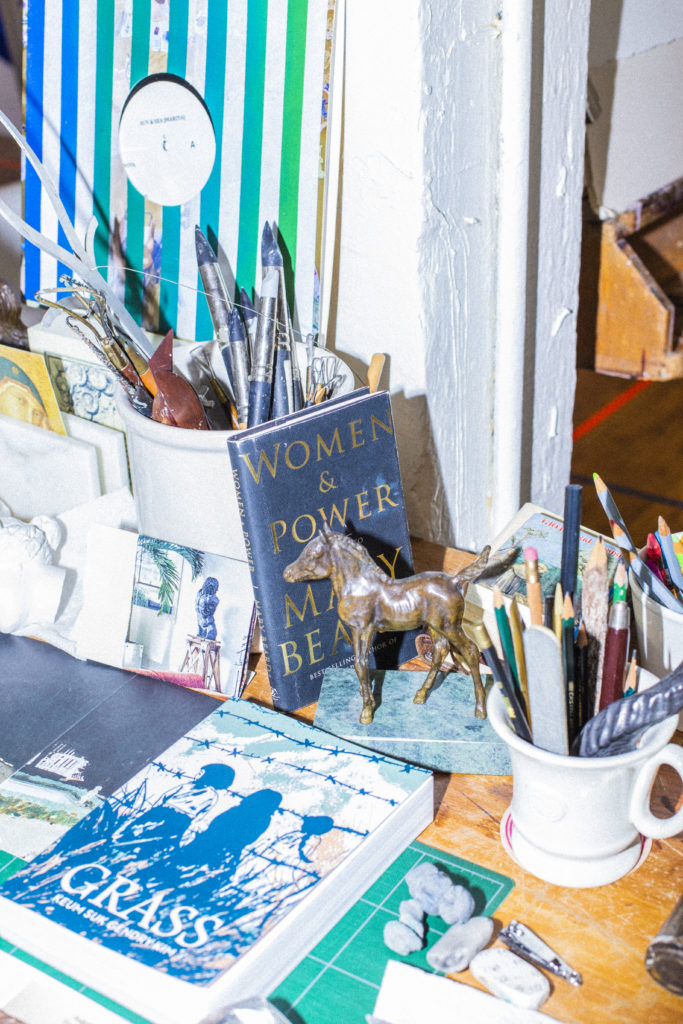
A detail from Cronin’s workspace. Photo courtesy Nicolas Bloise.
What art-related activities do you like to do together?
Kass: We’re very big on doing museums together, regardless of where we are in the world. And, on birthdays, that’s what we do.
Cronin: My birthday, for sure. For your birthday, we’re usually somewhere else. Out of town or out of the country. One of the things we love to do is travel to go look at art, whether it’s London or Paris or Rome or Venice. It just goes on and on. We make a real day of it when we do it.
How do you do it? Do you have viewing rituals?
Kass: We have lunch, we drink wine, we go back into the galleries. We go in and out. We’re really committed, and it’s really fun. But it’s very slow, exacting viewing. And then some wine.
What are some shows you’ve seen this year that you’ve found particularly interesting?
Kass: The impeachment has been particularly interesting.
Ah, yes, the longest-running show of the year. It’s felt like that, anyway.
Kass: And it’s the one that has interested me most by far. It’s insane. But really, I’ve been very lean this year, art-wise. I haven’t seen much. For three years, I’ve been watching political shows. But we might go to Paris, right, Patti? We want to see Leonardo [da Vinci] at the Louvre.
Cronin: I’m dying to go.
Kass: We saw the Titian show in Rome, at the Scuderie del Quirinale. We go to Rome a lot because Patti is a fellow at the American Academy and does research there. We spend a lot of time in Italy.
Cronin: But I think the Lithuanian Pavilion at the Venice Biennale was one of the best things I’ve seen in a very long time. There was also a Joseph Cornell show at the Prada Foundation that was really moving.
As two artists who live and work in the same space, what do you argue about?
Kass: We like different kinds of art for sure. A lot of times, it’s like, “Oh, right, of course you’d like that.” And it’s not quite my cup of tea. I like funnier art. And cartoonier art. So sometimes we argue about that.
Cronin: I like late Medieval and early Renaissance art. Which I still think is kind of funny, actually.
What art do you live with at home?
Kass: We have good art at home!
Cronin: Philip Guston, Elizabeth Murray, Adrian Piper, Rosa Bonheur, Harriet Hosmer, Karen Heagle, Catherine Opie, Timothy Greenfield Sanders, Keltie Ferris.
Kass: Cindy Sherman, Laurie Simmons. It goes on and on. Aline Kominsky-Crumb. Charles Schulz.
Cronin, Kass: Sister Corita! [both laugh]
And what does your home look like?
Kass: We have an 1850s townhouse in Boerum Hill. The living room has a lot of art in it, as does the dining room.
Cronin: Oh, and I forgot—Andy Warhol! That’s very important. We have a Warhol drawing of two boys kissing from 1952. It hangs over our bed.
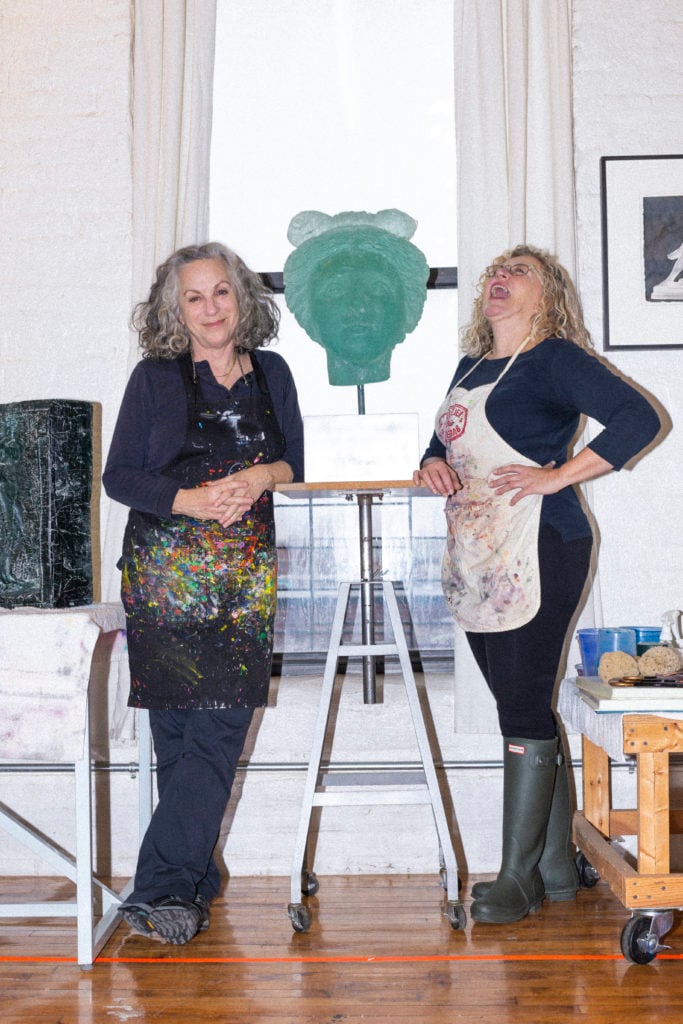
Cronin and Kass before Cronin’s glass sculpture of an Aphrodite head. Photo courtesy Nicolas Bloise.
That’s great. What, in your view, were the most important happenings in the art world this year?
Cronin: I think the Wangechi Mutu sculptures in the little niches of the Met façade and Simone Leigh’s Brick House installation on the High Line were both really important.
I think the national conversation about public monuments is really one of the most important things to have happened in the last 12 months. Women have been virtually absent in public for so long, and everyone’s trying to change that quickly now, to make up for all those centuries of not having them there. And they’re tripping over themselves a little bit, but the idea is right. The motivation is right, and the intention is right.
Kass: And the anxiety is right.
Cronin: That’s the burden of representation!
Kass: I was just going to say that. Those were my next words. But to be honest, Patti was dealing with this in 2001 with her public sculpture Memorial to a Marriage. Whenever she spoke about it, she’d say, “There are no real monuments of real women in New York City.”
Cronin: There were only five. There was a bust of [former Israeli prime minister] Golda Meir in Midtown; Eleanor Roosevelt in Riverside Park, though she only got installed in 1996; Joan of Arc by Anna Hyatt Huntington, also in Riverside Park; and then Alice In Wonderland and Mother Goose, both in Central Park. I’m also not talking about allegorical women like Lady Liberty and all that, I’m talking about sculptures of real women—and two of them are children’s storybook characters! So everyone is anxious because they’re trying to get it right now. That anxiety is great. At the same time, no one sculpture is going to be the answer for hundreds of years of omission. It’s going to take a lot more.
But you’re happy with how the conversation progressed this year.
Cronin: Yes! Because back in 2001, when I made Memorial to a Marriage and commented on the paucity of women being represented in public, I bought our burial plot in Woodlawn Cemetery. When I give my lectures, I always tell my female-artist friends, “If you want to make permanent public art, you’ve got to buy the land.” And that’s not how it should be.
Kass: Except now I have a permanent piece of public art in front of the Brooklyn Museum.
Cronin: It’s incredible.
Kass: It’s a riot, really. I can’t believe the museum stepped up in such a great way. It’s amazing, in fact.
What do you make of the reconfigured MoMA?
Kass: We haven’t been there yet.
Any thoughts without having gone?
Kass: My thought is this: I grew up in that museum, and I was upset with the first renovation. They’re now on the third. I never got over that Cézanne’s The Bather was moved in the first place, but I’ll adjust. I haven’t seen it, though.
Patti, you’re a professor of art at Brooklyn College. What is it like to be a professor at this critical moment in cultural and political history?
Cronin: Teaching at a public university in New York City, after teaching everywhere else, is great. I walk onto that campus and it still feels like New York City, which is really important.
Kass: And it’s filled with people who aren’t dying under the burden of loans.
Cronin: Most of our undergraduates are immigrants or first-generation Americans, or first-generation college students. They’re adorable, they’re from all over the world. They speak 180 languages. They’re incredible. I teach everything from Drawing 1 to graduate seminars. It just feels like the future is possible there, whereas at a lot of other places it doesn’t. I can’t imagine being a young student at an art school and leaving with $100,000 of student-loan debt. It’s criminal. So that’s why the City Universities of New York are quite special.
Looking ahead to the new year, what are you both working on? And what are you hoping will happen or change in 2020?
Cronin: I can’t tell you where it is, but I’m working on a major museum commission. And as soon as I can say anything, I will. That’s my main event, but I’m working on other projects as well.
Kass: The Tampa Museum of Art is working on fundraising for your piece.
Cronin: Yeah. They commissioned a monumental outdoor sculpture of Aphrodite. So they’re acquiring that, which is incredible. I’m the inaugural artist in a new series they’re doing called “Conversations with the Collection.” They have a contemporary art collection and an ancient Greek and Roman collection, and nothing really in between. So they’re asking contemporary artists to respond to their antiquities collection to bridge the gap.
Kass: I’m going to be having a show with Kavi Gupta Gallery in 2020. That’s cool. I’m having a show with Gavlak gallery in February. And I’m awaiting the end of fundraising for OY/YO at the Brooklyn Museum, which will be done soon. I’m awaiting a woman president. I’m waiting for Hillary—Clinton-Harris. That’s my ticket. But it’s not going to happen.
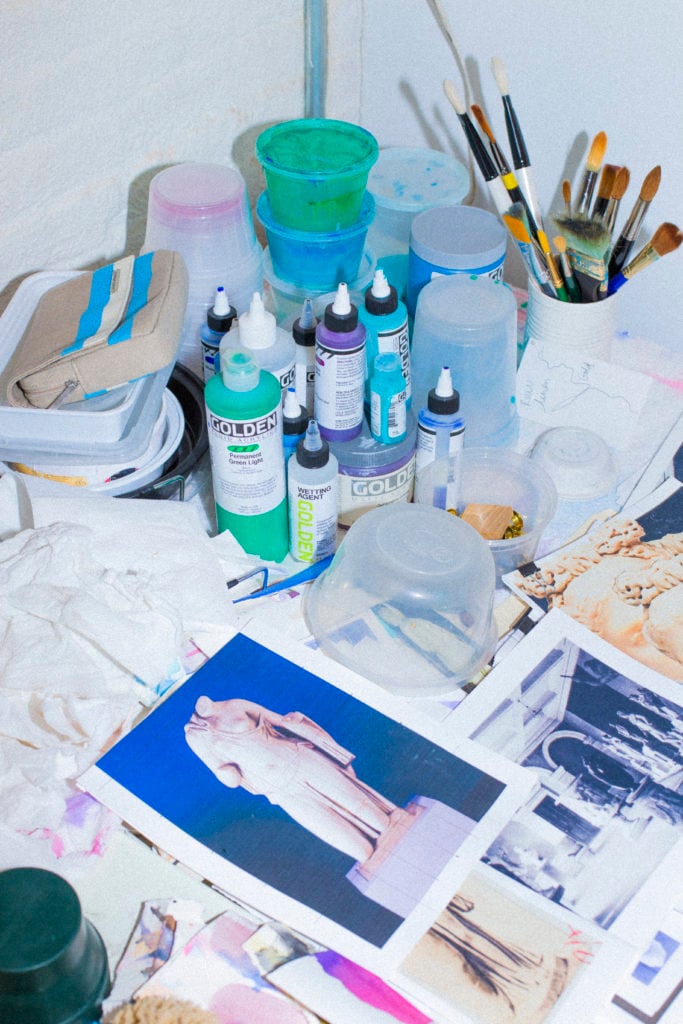
A close-up shot of Cronin’s reference materials. Photo courtesy Nicolas Bloise.
Were you upset when Harris dropped out?
Cronin: Yes. I was really surprised. Plus, I’d just given her money. [laughs]
Kass: I’d just bought something from her store. She was having a sale. I should have known.
Anyway, I hope, for the art world, that women begin to make as much money as men. And I hope that women artists have more prominent visibility.
Right. In Artnet’s Intelligence report this year, we found that, despite all the recent hype around major galleries and institutions promoting the work of women artists, they only represent 2 percent of the market. What do you think about that?
Kass: Oh yeah. I saved that article as a PDF. We know that.
Cronin: When Tom Finkelpearl was the commissioner of the New York City Department of Cultural Affairs, he had all the institutions do a study of how many people of color worked at the museums, and at what level—you know, upper leadership or security guard? It was a fantastic idea. When you do the same kind of study and ask, “How many works by women do you own, and how many works by men do you own?” it’s telling. If you have a $10 million Richard Serra, and you have a photograph by Carolee Schneemann that she was forced to donate to you, that is not an equal investment. So the women end up in the works-on-paper and peripheral ephemera categories, and the men end up with the monumental paintings and sculptures.
Kass: And I don’t want to hear about the three exceptions.
Cronin: There’s two ways to solve it, I guess. Women have to make more money and want to see their income-earning reflection in the culture, not just their trophy-wife reflection in the culture. And the men need to be retrained, or young men need to be educated better. I think if it was equal financially, collections in museums would look really different across all races, genders, and everything.
I know what they should do! A New York City museum should switch their acquisitions funding around just for one year. They should switch the little fund for the women’s committee with whatever they raise for the men’s collections and then see what happens.
What made you both want to be an artist in the first place? Are there any early artworks you can recall that informed your passion?
Cronin: I won first prize at my local library for an art contest for kids. I got to pick out a hardcover book from the library—any one I wanted. You might as well have told me I’d won a million dollars, you know? I grew up around Boston, so the Museum of Fine Arts was my hometown art go-to and it was really a privilege to be able to walk through an encyclopedic museum at such a young age. All that art history just got imprinted on me. I had such love for it, such awe. Like, what are all these things? Who made them?
Kass: My best friend’s mother was an art teacher at school, and she always says, “I take credit for you.” I learned to draw from MAD magazine. But Peanuts was my first experience of great art. Schulz was my first great visual artist. I wrote to him a lot. I sent him drawings.
Did he write you back?
Kass: Oh, yes. I got six letters from him.
Cronin: And one of them says, “Thank you for the drawings. It’s so good that your teacher puts them up! Keep it up, you never know where it might lead.”
Kass: That particular letter is in my Rizzoli book. It’s the sweetest thing. He kept all my drawings, and he never sent them back. It was really special because I was a very voracious culture vulture as a kid, with really no support from my parents. I was completely on my own.
Cronin: You used your babysitting money to see art!
Kass: I did! And the good thing is, my parents didn’t care that I got on a train and came to the city.
Do you remember the first museum show that you saw?
Kass: My father would take us to the Met when I was really little, and if you’re from the suburbs, I think one of your first class trips is to the Egyptian art rooms. So I was at the Met often. But I have a very distinct memory of seeing Picasso’s Portrait of Gertrude Stein—I was a little kid—and being completely struck by this image of this person and how different she looked from every other woman in the whole collection. She looked like people I knew. It was really important. It’s the first piece of art, outside of Peanuts, that I identified with. [laughs] She was a real person—not a lady, you know, with grapes.
Cronin: Right. I want to identify with works like that again! I want to see more politically risky art. I’m less interested in shiny, sparkly objects or, you know…
Bananas taped to the wall?
Cronin: Exactly. And obvious market darlings or people who are just printing money. That’s too emblematic of what’s going on. I got really excited when that new wave of freshmen senators got voted in during the midterm elections, and the art world seems to not have been able to catch up to that yet. At the same time, while people are saying, “Why aren’t the artists doing more work?” the artists actually are. You just have to look for the venues that present it to the public. It’s really their responsibility to show new and different work. And if they’d rather do shiny, sparkly objects it just holds up a mirror to a whole bunch of values that I’m frankly not interested in.
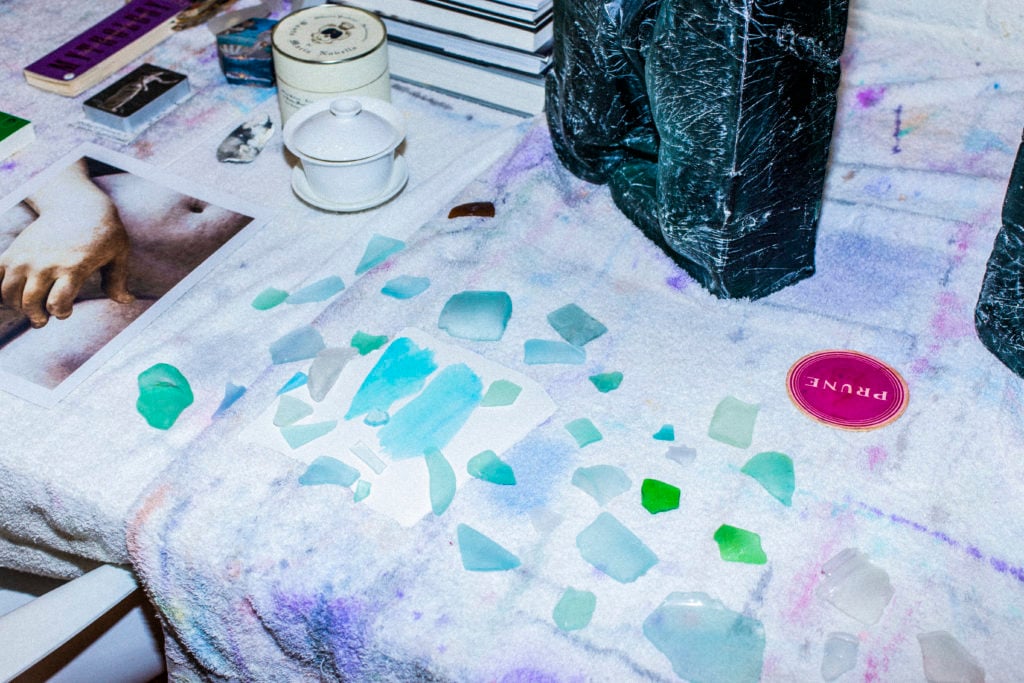
A detail from Cronin and Kass’s studio. Photo courtesy Nicola Bloise.
What’s the purpose of art today?
Kass: I have nothing to say on this.
Cronin: I think it’s the artist’s job to look out, see the world—keenly, hopefully—and reflect and respond. It’s the artist’s job to tell us what it’s like to be you, now. But I want to see courageous work. I want to be moved and provoked to think interesting things. I don’t want wallpaper. If I want wallpaper, I’ll go to a wallpaper store.
Kass: Ooh!
Do you think you’ll see that kind of work in the near future?
Cronin: Oh, I’m not a cultural curator. That’s on the venues. My job is to make the best, smartest work I can.
Finally, what’s the most important thing you’ve learned from each other?
Cronin: Don’t give up. March to your own drummer.
Kass: Don’t be a [jerk]. That’s one of my favorites.
Cronin: Yeah, but you didn’t learn that from me.
Kass: No, I didn’t. I learned that from life. I learned that from [jerks].
Cronin: But really, I think the main thing I’ve learned from her is to stay close to that inner core of steel within you. I try not to be distracted by the market or auction houses or things like that, and just try to aim really high and remain focused. What about you, Deb? What’s something you’ve learned from me?
Kass: How to follow a recipe?
Cronin: Actually, you haven’t learned that yet.
Kass: I’m trying.






